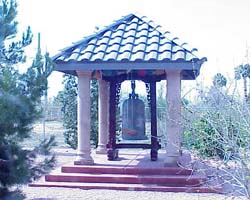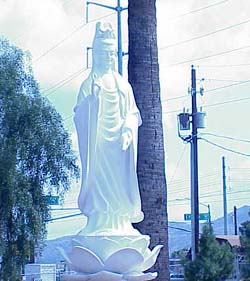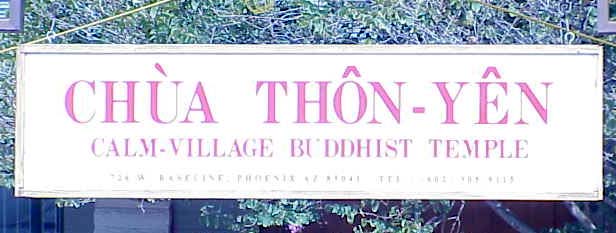|
Beyond the pool's fence
lies the rest of the temple grounds dominated by the main building (We
knocked but there was no response). In the June 3, 2001 Arizona Republic, A. Pancrazalo presents the
interesting fact that, before the temple was opened, this building had been
a drug house. There is also a stage nearby for addressing a large
congregation plus a huge table with dozens of unlit ceremonial candles
arranged on it. Hanging beneath a string of red lanterns in a miniature
temple of its own guarded by red wooden lions is the “Great Awakening Bell”,
said to produce the “voice of the Buddha” when struck. Overall, this is a
very tranquil and calming place!
response). In the June 3, 2001 Arizona Republic, A. Pancrazalo presents the
interesting fact that, before the temple was opened, this building had been
a drug house. There is also a stage nearby for addressing a large
congregation plus a huge table with dozens of unlit ceremonial candles
arranged on it. Hanging beneath a string of red lanterns in a miniature
temple of its own guarded by red wooden lions is the “Great Awakening Bell”,
said to produce the “voice of the Buddha” when struck. Overall, this is a
very tranquil and calming place!
|
|
|
The
built environment is not the only sign of the great diversity in this area.
As our group ate lunch and watched the people going from place to place, I
noticed members of many different cultures passing by, a testament to South
Phoenix’s place as a refuge from the homogenized whiteness of the typical
Phoenix neighborhood. (Overall, Phoenix is over 71% Anglo – South Phoenix only 32.8% Anglo)(Morrison Institute, 22 & Burns/Gober,
16). The presence of the temple, along with all of the other evidence of
non-Anglo culture seems to bear out the Morrison Institute for Public
Policy’s assertion in Hits and Misses: Fast Growth in Metropolitan
Phoenix that “unlike their European predecessors, [who] felt
acculturation was necessary in order to succeed…today’s ethnic minority
immigrants are attempting to maintain their cultural identities”.
Anglo – South Phoenix only 32.8% Anglo)(Morrison Institute, 22 & Burns/Gober,
16). The presence of the temple, along with all of the other evidence of
non-Anglo culture seems to bear out the Morrison Institute for Public
Policy’s assertion in Hits and Misses: Fast Growth in Metropolitan
Phoenix that “unlike their European predecessors, [who] felt
acculturation was necessary in order to succeed…today’s ethnic minority
immigrants are attempting to maintain their cultural identities”.
Turning away from the reflecting pool, I look over my shoulder to the North
and notice the clear, postcard-like view of downtown Phoenix from the rarely
seen (for most Phoenicians) southern perspective. The uniqueness of this
place ought to be included in the overall picture of the city.
|
|
